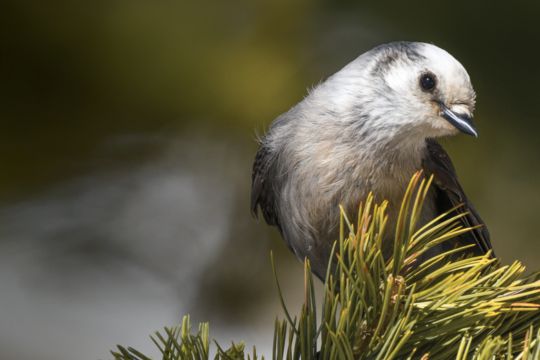
Spring is the time migrant birds return to Canada, which they use as a breeding ground, free of southern predators.
If you’re reading this over a springtime morning coffee, there are many other Canadians already outside looking for, and at, birds. Some will be glancing at an app called Merlin, or checking email for where that recent flock of yellow-headed blackbirds was last seen. Others, old-school for sure, will be carrying field guides or online versions of Peterson Field Guide to Birds (of Eastern or Western, or all of North America), or National Geographic’s guide or The Sibley Guide to Birds.
Some people retain family stories of how they got hooked. Mine was the “other” grandfather, not a Bird but a Bradshaw, a British man who started out as an egg “collector” (i.e., he robbed nests), and changed late in life to an amateur field naturalist, content just to spot returning birds every spring. He took me along.
In doing so, I became part of a community whose participants send about 1.3 million checklists every year to the online eBird website, boosting their own self-esteem and contributing to a mainstay of how Canadians keep tabs on the natural world. eBird is a worldwide bird monitor operation, and in Canada as elsewhere, the pandemic vastly increased its data storehouse (and data for science).
Birders get “out there” more than the average citizen, but vary hugely in knowledge and dedication. Some get a bang out of whatever shows up in a backyard, in bushes or trees down the street, or on or above any nearby water. Others drive great distances to chase a reported rarity. I once drove from Ottawa to Presqu’ile Provincial Park on Lake Ontario to see a boreal chickadee. When I got there, I headed toward a crowd peering into a bush, and added this tiny brown-capped (as opposed to the common black-capped chickadee) species to my life list.
This popular recreation requires only a field guide and a pair of binoculars. It pays to set the alarm early (an early birder gets more birds.) There is much birding help available online: Besides eBird, check out Fat Birder, 10,000 Birds, and Cornell University’s Bird Lab. Find out online where your local hotspots are and head for anyone in view carrying binoculars. Be realistic — what you see will not look like a David Suzuki TV feature. His brilliant shots of birds (or bears or wolves or beavers) were taken by photographers who sat in heat, cold, rain, wind, for hours, waiting for a fleeting photo-op.
The first rule of birding for experts and ordinary people alike is “be lucky.” The second rule is “be patient.” The third is “be quiet.”
Most birds, most of the time, don’t want to be seen as a potential meal for a predator. What a birder often will see with the naked eye is just movement — behind a leaf, around a tree trunk, in leaves on the forest floor, amidst grasses in a field or reeds in a marsh.
Then it’s time for binoculars. Binoculars are almost a must if you want to identify a bird you’ve never seen before. John James Audubon had no binoculars, so how did he get close enough to execute his astonishing images of what he saw? He shot them with a gun, a custom frowned upon in our era. Many birders use “spotting” telescopes (as compared to celestial scopes) mounted on tripods but skip that expense until you’re well hooked on this pastime.
Binoculars in hand, focus on the area where movement happened, and raise the binoculars to your eyes. Don’t try to find a bird through binoculars. Some birds, such as the western tanager and the scarlet tanager have easy-to-see brilliant colours. But others aren’t so colourful. A red-eyed vireo makes up for its drab appearance by singing endlessly (Cornell University’s bird lab reports up to 20,000 repeats in a single day) — enough to brighten anyone’s outlook. It has a longish song — “here-I-am, in-the-tree, look-up, at-the-top” — as rendered by David Sibley.
Anyone with a better “translation” than Sibley’s for birdsong deserves a coffee, but learning songs and calls helps, because birds are often heard before seen. Their songs function to attract and retain a mate or reinforce a bird’s claim to a territory but are a boon to birdwatchers.
Spring is special because it is arrival time for migrants, especially warblers, a biological “family” of tiny, colourful migrants, which spend most of the year in Central or South America, or the U.S. south. They head to our part of the world, which they use as a maternity ward. They mate and raise young free of southern predators and fill up on insects and caterpillars. Black fly and mosquito season may be bad news for humans, but it’s a crucial time for warblers.
Come summer, most birds stay hidden as much as possible while they raise their young. They’re out and about again in fall, but adults look faded because breeding plumage has gone downhill and fledglings are only partially on the way to adult colours.
Spring is calling. Go for it.
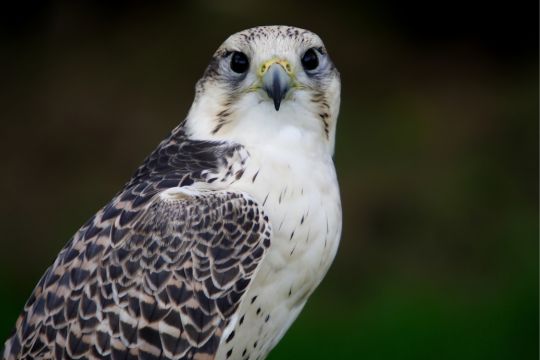
The gyrfalcon, the largest of the falcon species, is the official bird of the Northwest Territories.
Our home and native birds
A look at Canada’s official provincial and territorial birds.
- Canada’s national bird is the Canada jay and each province and territory also has its own bird symbol.
- Up north, Nunavut’s choice is the rock ptarmigan. Like its genetic relatives (including wild turkey and ruffed grouse), it lives year-round in Canada’s Arctic archipelago, nesting on the ground. The Ptarmigan doesn’t migrate. It eats short vegetation, supplemented by insects and snails.
- Moving west, the Northwest Territories’ bird is the gyrfalcon, a huge version of the peregrine falcon and American kestrel, both of which flourish all over North America. Gyrfalcons pretty much stay north, but have been seen occasionally in the south of Canada, astonishing lucky bird-watchers. Their feathers vary from pure white to mottled brown.
- Yukon’s bird is the common raven, a beefy relative of the American crow. Its distinguishing characteristic is voice — ravens say “croak”; crows say “caw.” A raven in the neighbourhood is bad news for juvenile birds of other species, so smaller birds often mob the intruder to drive it away.
- Steller’s jay is British Columbia’s official bird. It is iridescent blue, with a noisy call. Like its cousin the blue jay in the east, it’s tolerant of people and knows that campgrounds and picnic areas are where to find something to eat. However, it’s not that tolerant — it won’t land on your hand for an offered peanut as readily as a tiny chickadee.
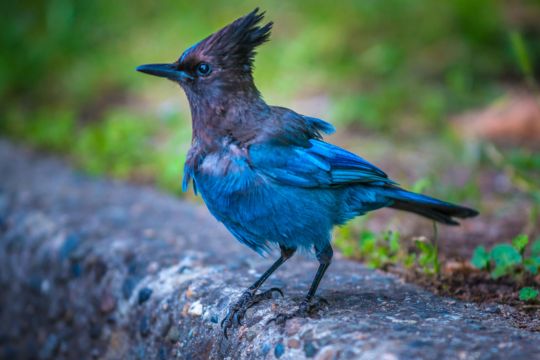
The Steller's jay, a frequent visitor to feeders, picnics and campsites, is the provincial bird of British Columbia.
- Three provinces have chosen big owls as their official bird, and Alberta’s is the aptly named great horned owl, with a wingspan almost 1.5 metres across. Rarely heard, more often seen by birders, the great horned attracts a crowd fast. It lives in forests, suburbs and even deserts from Alaska to Central America.
- The sharp-tailed grouse is official in Saskatchewan. A grassland bird, it’s noted for purple neck sacks, which inflate during courtship. It behaves like a domestic chicken, foraging on the ground. Saskatchewan has more of these birds than any other jurisdiction in North America.
- Next door, Manitoba is home to another big owl species also aptly named the great grey owl, which has a wingspan of about 1.2 metres. Its normal range in Canada is from the Yukon to the Ontario-Manitoba border, but it occasionally erupts eastward. This movement is often deadly, with these owls vulnerable to collisions with motor vehicles.
- Ontario’s official bird, the common loon, has been heard uncounted times via the soundtrack of TV programs and movies with outdoor settings. It’s a near-hopeless walker on land, but successfully hunts fish underwater. It builds a semi-floating nest.
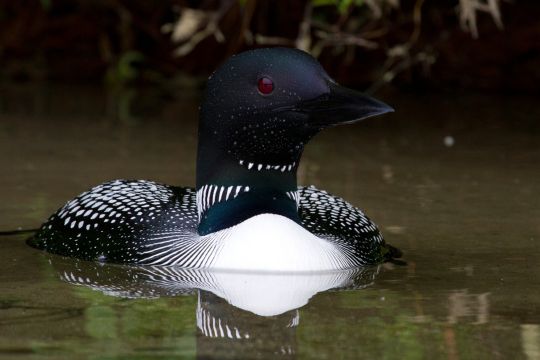
The common loon, known for its distinctive call, is the provincial bird of Ontario.
- Quebec’s snowy owl breeds in the Arctic and migrates south in winter. Pure white to mottled brown, it matches varied snow cover, and it’s silent except during breeding up north. Snowies eat pretty much anything they can catch — fish, rodents, squirrels, rabbits, ducks and songbirds.
- The black-capped chickadee gets official recognition only in New Brunswick. It’s deserved — this bird is often an introduction to the natural world for children. Give children birdseed, tell them to hold it up in their hands and chances are a chickadee arrives to eat. The familiar “chick-a-dee-dee-dee” call and the less recognized “spring soon” are heard year-round.
- Nova Scotia, rooted in the fishing industry, chose the osprey, a raptor that fishes spectacularly, hovering over the water and then diving down to and under the surface to emerge with a fish in its claws. It rotates the fish until it’s head-first and flies off to perch and eat. What a show.
- Prince Edward Island has one of Canada’s greatest show-offs, the blue jay. Related to crows and ravens, it scavenges off people. It’s also expert at cracking open seeds and stealing eggs from other birds’ nests. Common across the country except for British Columbia, it rivals the raven for brain power and imagination.
- Hardy and weird looking, the Atlantic puffin dives for fish in Atlantic waters as far north as Greenland. In Canada, its home range includes the waters around Newfoundland and Labrador, which claims it as provincial bird. It takes its catch home to small offshore islands where puffin chicks shelter on rocky ground.
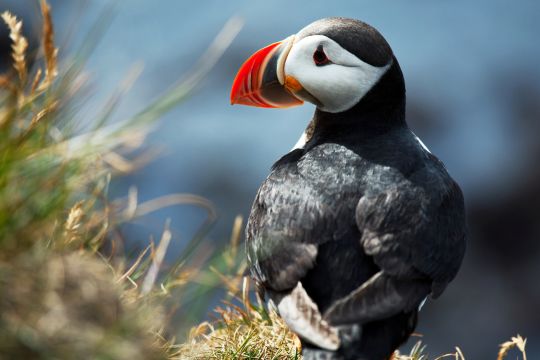
The Atlantic puffin, a social bird that lives in large colonies, is the official bird of Newfoundland and Labrador.
Looking for loons
Want to do your part for conservation of Canadian lakes? You can join the Canadian Lakes Loon Survey, a project by Birds Canada to help understand why loons are disappearing. Survey participants have been tracking common loon breeding by monitoring chick hatch and survival since 1981. Participants dedicate at least three days, visiting their lake once in June (to see if loon pairs are on territory), once in July (to see if chicks hatch) and once in August (to see if chicks survive long enough to fledge.)
For more information, visit: Birds Canada.

